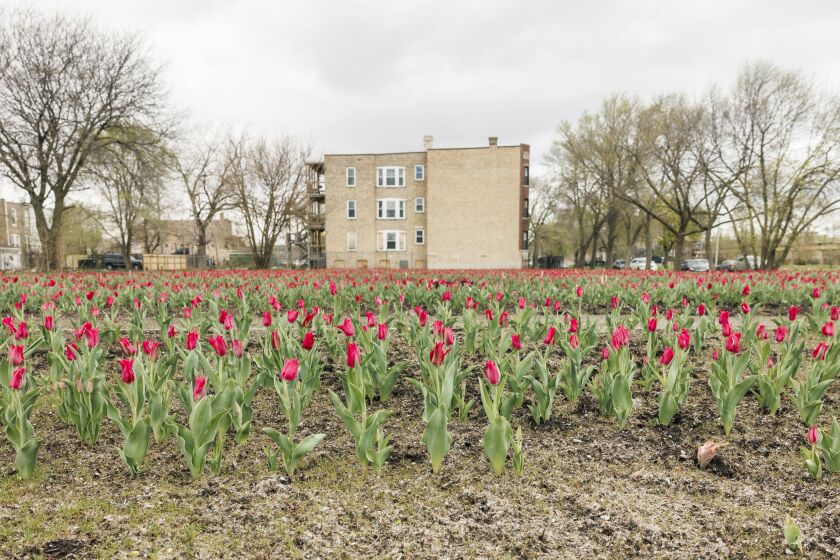Before tulips covered the ground at 53rd and Prairie Avenue, before it became a vacant lot, a six-flat stood there, housing a barbershop, an underground lottery and a number of residents, including Vivian Johnson, who was born there in 1935.
The building was one of several that stood near that intersection in Washington Park and throughout the South Side that have since been destroyed and left vacant.
Today, the lots are blooming with 100,000 red tulips planted in the shape of the houses that stood there as part of artwork by artist Amanda Williams.
The work, titled “Redefining Redlining,” aims to highlight the discriminatory practices that led to their destruction as well as many others throughout Black Chicago neighborhoods.
Williams and a team of graduate students are researching what led to the destruction of the buildings where the tulips are now and who lived there, but Johnson, 88, remembers firsthand.
“There was always music in the house,” Johnson said of the apartment at 5258 S. Prairie Ave., where her family lived until she was 6.
The family lived on the ground floor in a two bedroom apartment where she shared a bed with her two younger sisters, Johnson recalled.
“Two of us at the head and one at the foot” was how they used to sleep, she said.
Their mother, Virgie, was a homemaker and pianist who played in a local Baptist church, while their father, Jesse, was a plasterer for a construction company. Virgie would play Gospel music on the piano at home.
The couple met in Chicago, having both moved to the city from the South as part of the Great Migration, married in 1934 and wound up having six children.
They left the Prairie Avenue apartment at the end of the summer of 1941 after having their fourth child, when Johnson was 6.
They moved to a larger apartment about a mile north at 49th and Vincennes Avenue, but Johnson always liked the Prairie Avenue apartment best.
She recalled the pretty girl who lived upstairs whose dimples were the envy of the Johnson sisters; the red and white barber pole that signaled the barbershop that operated out of the basement; and the pretty French doors that separated the dining room from the living room inside the apartment, where she first developed a love for learning.
Neighbors visited to try their luck at the underground lottery run out of the barbershop, but the greatest excitement was outside. Kids gathered for baseball and double dutch, a house down the street would occasionally be quarantined due to scarlet fever, and from time to time, the stuff of nightmares came looming down the street.
“There was a man who used to come through the neighborhood on stilts, dressed in red white and blue, and holding a sign saying ‘Uncle Sam wants you,’” Johnson said, recalling the fear the figure inspired.
“Naturally, us being little children, we’d break our necks running back up into the house,” she said.
This was before Pearl Harbor drew the U.S. into the war in 1941.
Even at that young age, Johnson could read the man in stilts’ draft sign after learning to read while playing at home.
“We would just play school,” she said. “We’d have spelling bees and everything, so when we went to school, most of it we already knew.”
She attended Burke Elementary, about a quarter-mile away from the house.
Once, she played hooky, albeit inadvertently.
“The teacher let us out for recess, and I walked right on home. I thought school was done,” Johnson said. “When I got home, my mother had to explain what recess was.”
After the family moved, Johnson never returned to the neighborhood and only realized the houses had been torn down when she drove through the area about a decade ago.
“I remember I liked it better than where we moved,” she said.
Michael Loria is a staff reporter at the Chicago Sun-Times via Report for America, a not-for-profit journalism program that aims to bolster the paper’s coverage of communities on the South Side and West Side.






